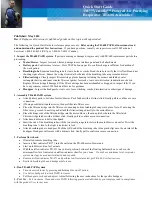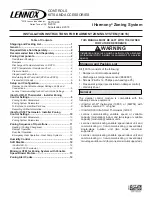
EqUIPMENT SAFETY DATA
Safety Data
R407C
Toxicity
Low
In contact with skin
Liquid splashes or sprays may cause freeze burns. Unlikely to be hazardous by skin absorption.
However, R407C may be slightly irritant and, if liquid, it has a strong degreasing effect. Flush contaminated skin
areas with running water. If it comes into contact with wet fabrics, the liquid refrigerant will cause them to freeze
and adhere to the skin. Carefully remove the contaminated clothing since it might adhere to the skin and cause
freeze burns. Apply to a doctor if the affected skin areas should be reddened or irritated.
In contact with eyes
vapours have no effect. Liquid splashes or sprays may cause freeze burns. In these cases rinse your eyes with
running water or with a solution for eye lavages for at least 10 minutes. Immediately apply to a doctor.
Ingestion
very unlikely to occur. If this should be the case, it may cause freeze burns. Never induce vomiting.
keep the patient awake. make it rinse its mouth with running water and make it drink about 1/4 of a litre.
Immediately apply to a doctor.
Inhalation
R407C: High concentration levels of its vapours in the air can produce an anaesthetic effect, including the loss of
consciousness. particularly severe exposures may cause heart arrhythmia and sometimes prove to be also fatal.
At high concentrations there is a danger of asphyxia due to a reduced oxygen content in the atmosphere. In these
cases take the patient to the open air, in a cool place and keep it at rest. Administer oxygen, if required. Apply
artificial respiration if breathing has ceased or if it has become irregular. In case of heart failure immediately apply
cardiac massage. Immediately apply to a doctor.
Further medical Advice A symptomatic and supportive therapy is generally suitable. A heart sensitisation has been observed in some cases,
as a result of exposures to particularly high concentrations. In the presence of catecholamines (such as for exam-
ple adrenaline) in the blood flow, it has increased the irregularity of the cardiac rhythm and then caused the heart
failure.
Long-term exposure
R407C: A lifetime study which has been conducted on the effects inhalation may have on rats at 50,000 ppm has
shown the onset of benign tumours of the testicle. These remarks suggest that there is no danger for human beings
if they are exposed to concentrations below the occupational limits or equal to them.
Occupational exposure
limits
R407C: Recommended limits: 1,000 ppm v/v
8 hours TWA.
Stability
R407C: Not specified.
Conditions to avoid
Use in the presence of exposed flames, red heat surfaces and high humidity levels.
Hazardous reactions
possibility of violent reactions with sodium, potassium, barium and other alkaline substances.
Incompatible materials: magnesium and all the alloys containing over 2% of magnesium.
Hazardous decomposi-
tion products
R407 C: Halogen acids deriving from thermal decomposition and hydrolysis.
General precautions
Avoid the inhalation of high concentrations of vapours. The concentration in the atmosphere shall be kept at the
minimum value and anyway below the occupational limits. Since vapours are heavier than air and they tend to sta-
gnate and to build up in closed areas, any opening for ventilation shall be made at the lowest level.
Breathing protection
In case of doubt about the actual concentration, wear breathing apparatus. It should be self-contained and appro-
ved by the bodies for safety protection.
Storage preservation
Refrigerant containers shall be stored in a cool place, away from fire risk, direct sunlight and all heat sources, such
as radiators. The maximum temperature shall never exceed 45°C in the storage place.
protection clothes
Wear boots, safety gloves and glasses or masks for facial protection.
Behaviour in case of
leaks or escapes
Never forget to wear protection clothes and breathing apparatus. Isolate the source of the leakage, provided that
this operation may be performed in safety conditions. Any small quantity of refrigerant which may have escaped
in its liquid state may evaporate provided that the room is well ventilated.In case of a large leakage, ventilate the
room immediately. Stop the leakage with sand, earth or any suitable absorbing material. prevent the liquid refrige-
rant from flowing into drains, sewers, foundations or absorbing wells since its vapours may create an asphyxiating
atmosphere.
Disposal
The best procedure involves recovery and recycle. If this is not possible, the refrigerant shall be given to a plant
which is well equipped to destroy and neutralise any acid and toxic by-product which may derive from its disposal.
Combustibility features R407C: Non flammable in the atmosphere.
Containers
If they are exposed to the fire, they shall be constantly cooled down by water sprays.
Containers may explode if they are overheated.
Behaviour in case of
fire
In case of fire wear protection clothes and self-contained breathing apparatus.
4
Содержание X AO
Страница 2: ......






































